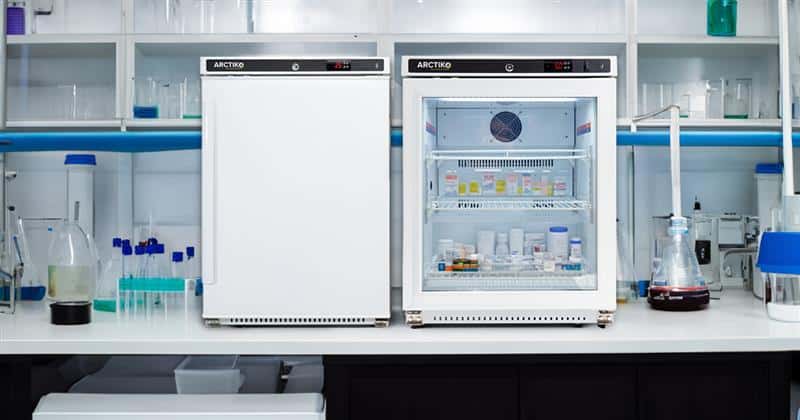Ensuring the safety and efficacy of temperature-sensitive medical supplies is critical in any medical setting. Choosing the right medical refrigeration units such as refrigerators or freezers is, therefore, essential.
With so much to consider, we put this helpful guide together exploring some of the key features you should look out for when choosing your perfect laboratory or pharmacy refrigeration unit. However, in this article, we explore the key considerations and compare the benefits and drawbacks of solid and glass door models in medical refrigeration units.

Glass Door Advantages
If you prefer ease of use, a glass door may be the choice for you. Staff are able to locate vaccines and medications and carry out stock checks without needing to open the door. With instant visibility, contents can be viewed without having to open the door. Less door openings results in reduced cold dispersion and improved thermal stability inside the unit reducing the opportunity for spoiled vaccines and medication. Besides their practical benefits, glass door medical refrigeration units also enhance the aesthetic appeal of the workplace, blending seamlessly into the environment and improving the overall look of the space.
Glass Door Disadvantages
Although ideal in some cases, complete visibility inside the refrigeration unit does present privacy issues. A glass door allows anyone to see the contents of your medical refrigeration unit, which can be problematic if you want to keep items private and could potentially encourage theft. Although still highly insulated, a glass door is slightly less insulated in comparison to a solid door version. Glass doors, while often designed with technologies like double glazing and Low-E coatings to enhance their insulation, inherently offer slightly less insulation compared to solid doors due to the higher thermal conductivity. Additionally, products that are light-sensitive may be affected if kept in a glass door refrigerator, leading to spoilage and the need for disposal.
Solid Door Advantages
Solid door models as mentioned above, offer better thermal insulation. They are also ideal when storing light-sensitive products, as there is no need to worry about light entering the refrigerator through the door, ensuring your supplies remain safe. Additionally, a solid door keeps the contents of a medical refrigeration unit out of sight, maintaining privacy. Solid doors reduce the risk of condensation, which can sometimes form on glass doors and obscure the view inside the refrigerator. With solid door medical refrigerationunits, this concern is eliminated.

Solid Door Disadvantages
One of the few disadvantages of a solid door refrigerator is that you cannot see the contents without opening the door. Prolonged or frequent door openings can lead to changes in the internal temperature, potentially causing vaccines and other stored items to deteriorate or spoil.
When selecting medical refrigeration units, several factors should be taken into account:
- What is the intended use? Determine whether you need the unit for storing vaccines, medications or laboratory samples. For regulatory standards, refer to the Centres of Disease, Control and Prevention (CDC) vaccine storage and handling
- What dimensions are required?
- What regulatory standards must be met? – Check the unit meets all necessary regulations and standards. The US Food and Drug Administration (FDA) Regulations provide comprehensive guidelines.
- What is your budget?
- What temperature range needs to be maintained?
For more details on these considerations, read our article.
ARCTIKO’s Flexaline Range

Our latest range of Flexaline models offers the best of both worlds with options for both solid and glass doors. Additionally, you can choose from a variety of sizes to suit your needs and facility. With medical refrigeration units available in both refrigerators and freezers, you can find out more about the range here and pick the right solution for you.

 Fast Delivery
Fast Delivery  Global Compliance
Global Compliance  Long Term Support
Long Term Support